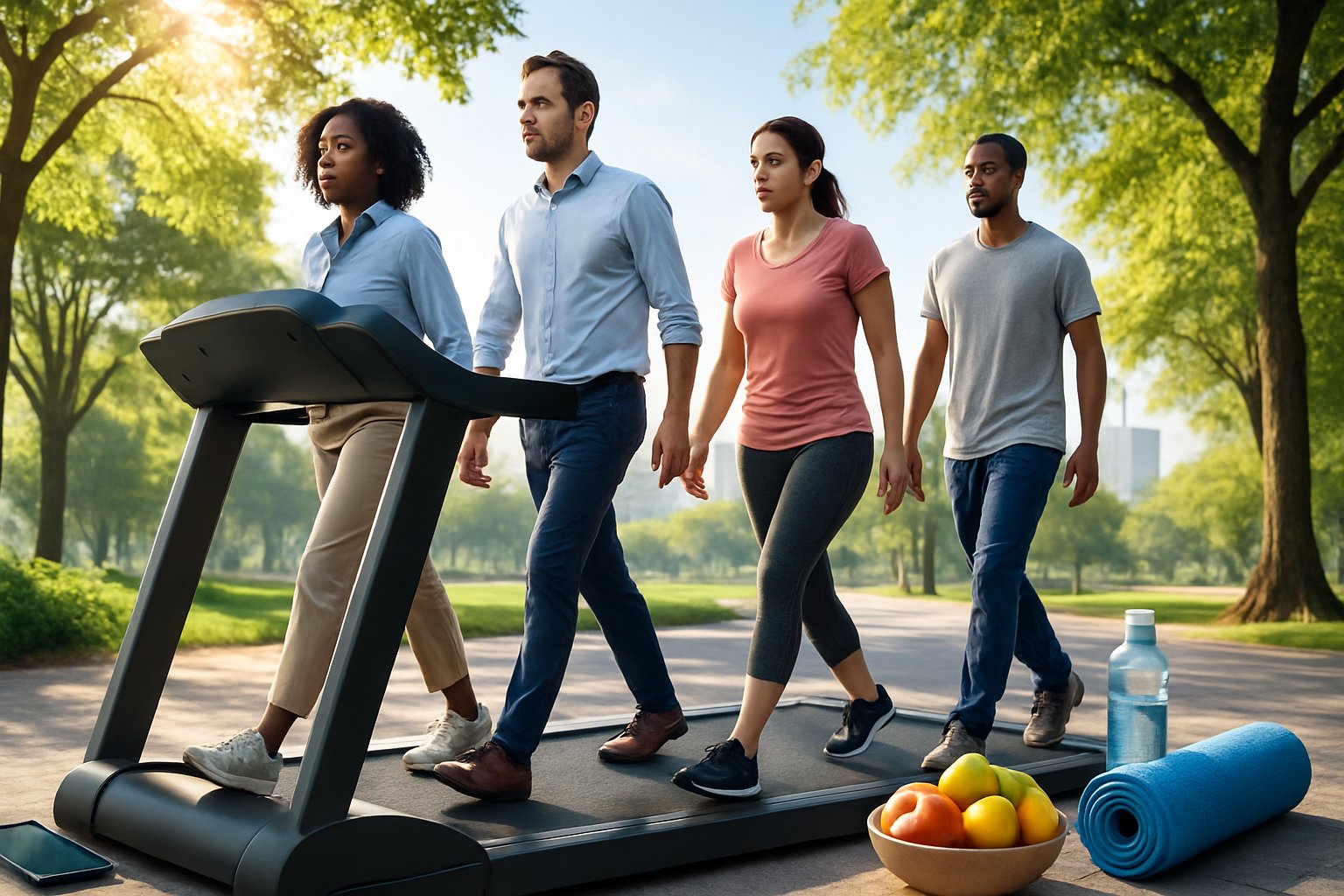Have you ever wondered why that promotion, new car, or dream vacation didn’t make you as happy as you expected for as long as you thought it would? You’re experiencing what psychologists call the hedonic treadmill, a fascinating aspect of human psychology that affects everyone’s pursuit of happiness.

The hedonic treadmill explains why people quickly return to a stable level of happiness despite major positive or negative life events. This psychological phenomenon reveals that humans naturally adapt to changes in their circumstances, whether good or bad. When someone gets a raise, buys a luxury item, or achieves a major goal, they experience a temporary boost in happiness before returning to their baseline emotional state.
Understanding the hedonic treadmill can transform how people approach their goals and expectations. Rather than constantly chasing the next big thing for lasting happiness, individuals can learn to recognize this pattern and develop more effective strategies for genuine well-being. The science behind this concept offers valuable insights into why adaptation affects happiness levels and how to work with this natural tendency instead of against it.
Key Takeaways
- People naturally return to their baseline happiness level after both positive and negative life events due to psychological adaptation
- The brain’s tendency to adapt to new circumstances means that external achievements provide only temporary happiness boosts
- Breaking free from the hedonic treadmill requires focusing on meaningful activities, personal growth, and gratitude rather than material pursuits
What Is the Hedonic Treadmill?

The hedonic treadmill describes how people return to a stable happiness level despite major life changes. This psychological concept involves adaptation processes, foundational research studies, and individual baseline happiness levels that shape how we experience well-being over time.
Defining Hedonic Adaptation
Hedonic adaptation refers to the process where humans quickly return to a relatively stable level of happiness despite major positive or negative life events. This psychological concept explains why people maintain fairly consistent happiness levels throughout their lives.
The term “hedonic treadmill” creates a powerful comparison. Like running on a treadmill, people can work hard to increase their happiness but often end up in the same emotional place they started.
Key characteristics of hedonic adaptation include:
- Quick return to baseline happiness levels
- Occurs after both positive and negative events
- Involves cognitive and neurochemical changes
- Affects expectations and desires over time
The hedonic treadmill theory suggests that as people gain more money or positive experiences, their expectations rise equally. This creates no permanent gain in happiness levels.
The adaptation process involves several mechanisms. People shift their attention, change their values, and reinterpret situations. These cognitive changes help explain why lottery winners often return to previous happiness levels within months.
Origins and Key Studies
Brickman and Campbell first introduced the hedonic treadmill concept in 1971. Their groundbreaking article “Hedonic Relativism and Planning the Good Society” described how people maintain stable baseline happiness despite external changes.
The most famous study on hedonic adaptation compared lottery winners to accident victims in 1978. Brickman, Coates, and Janoff-Bulman interviewed 22 lottery winners and 29 paraplegics to measure happiness changes.
Study findings revealed:
- Lottery winners reported similar happiness before and after winning
- Paraplegics expected to return to baseline happiness levels over time
- Both groups showed adaptation to their new circumstances
- Initial emotional impact faded within months
The research built on Helson’s adaptation level theory from psychology. This framework suggests that people judge experiences by comparing them to previous situations rather than absolute standards.
Later studies refined these findings. Researchers discovered that adaptation rates vary between individuals and that some life events create longer-lasting changes than others.
The Role of Baseline Level of Happiness
Each person has a baseline level of happiness that acts like an emotional home base. This set point influences how they experience and recover from life events.
Research shows that genetics account for approximately 50% of happiness levels. Twin studies demonstrate that people inherit tendencies toward certain emotional ranges from their parents.
Factors that influence baseline happiness:
- Genetic predisposition – inherited emotional tendencies
- Personality traits – extraversion, neuroticism, openness
- Individual adaptation speed – how quickly people adjust
- Life circumstances – ongoing situations and relationships
The baseline is not completely fixed. About 25% of people experience shifts in their happiness set point over time. Major life changes like disability, divorce, or unemployment can create lasting changes for some individuals.
Modern research describes the happiness set point as a “soft baseline.” Most people hover around their typical happiness level, but this range can move up or down based on significant experiences and personal resilience factors.
How the Hedonic Treadmill Works

The hedonic treadmill operates through a natural adaptation process where people adjust to both positive and negative changes in their lives. This psychological mechanism explains why lottery winners and accident victims both returned to their pre-event happiness levels within months or years.
Adaptation to Positive Events
When positive events occur, people initially experience a significant boost in happiness and life satisfaction. However, the hedonic treadmill works through a process called habituation, where the brain becomes accustomed to new circumstances.
Common positive adaptations include:
- New purchases losing their excitement
- Job promotions becoming routine
- Relationship milestones feeling normal
- Achievements providing temporary satisfaction
The brain treats positive changes as the new normal. What once brought joy becomes background noise in daily life.
Research shows that lottery winners experience this pattern clearly. Their initial happiness spike fades as they adapt to their new wealth. The money stops feeling special or exciting.
This happens because expectations rise alongside circumstances. When someone gets a raise, they often increase their spending and lifestyle expectations. The improved situation no longer feels like an improvement.
The adaptation process typically takes several months to complete. During this time, the positive feelings gradually decrease until happiness returns to baseline levels.
Adjustment After Negative Events
Negative events create the opposite pattern but follow similar adaptation rules. People initially experience drops in happiness and life satisfaction after difficult circumstances. Yet they typically recover to their previous emotional baseline over time.
Studies of accident victims demonstrate this resilience. Despite facing major life changes, most people adapt and return to their pre-accident happiness levels. The human mind shows remarkable ability to adjust to new realities.
Key factors in negative adaptation:
- Coping mechanisms develop over time
- Social support helps speed recovery
- Perspective shifts reduce impact
- New routines create stability
The brain naturally adjusts expectations downward after negative life events. What initially seems devastating becomes manageable as people find ways to cope. They discover new sources of meaning and satisfaction within their changed circumstances.
This adaptation protects mental health by preventing permanent happiness loss. Without this mechanism, negative events would compound and create lasting emotional damage. Instead, most people show surprising resilience in recovering their baseline happiness levels.
Scientific Evidence and Real-Life Examples

Multiple studies have documented how people adapt to major life changes, returning to baseline happiness levels. Research shows that lottery winners experience temporary happiness spikes before adapting, while wealth beyond basic needs provides diminishing returns on life satisfaction.
Lottery Winners and Accident Victims
The most famous study on hedonic adaptation examined three groups: lottery winners, accident victims who became paralyzed, and a control group. Brickman, Coates, and Janoff-Bulman conducted this groundbreaking research in 1978.
Key Findings:
- Lottery winners showed temporary happiness increases
- Accident victims experienced initial drops in well-being
- Both groups returned close to their original happiness levels over time
The lottery winners adapted to their new wealth within months. Their daily pleasures became less intense as expensive items became normal.
Accident victims demonstrated remarkable resilience. They developed new coping strategies and found meaning in their changed circumstances.
This study proved that major life events have less long-term impact on happiness than people expect. The human brain’s survival mechanism helps people adapt to both positive and negative changes.
Wealth and Happiness
Research reveals a complex relationship between money and life satisfaction. Studies show that beyond approximately $75,000 per year, additional wealth has diminishing returns on happiness.
Income Thresholds:
- Below $30,000: Strong correlation between money and happiness
- $30,000-$75,000: Moderate correlation
- Above $75,000: Weak correlation
Wealthy individuals often experience lifestyle inflation. They upgrade homes, cars, and vacations but adapt quickly to these improvements.
National income studies show that long-term increases in wealth do not lead to sustained increases in overall happiness. Countries with growing economies don’t necessarily have happier populations over decades.
The hedonic treadmill explains why billionaires aren’t proportionally happier than millionaires. Both groups adapt to their material possessions and seek new achievements.
Material Possessions Versus Experiences
Research consistently shows that experiences provide longer-lasting happiness than material purchases. People adapt more slowly to experiential purchases than physical items.
Why Experiences Beat Possessions:
- Create lasting memories that improve over time
- Provide social connections and shared stories
- Offer novelty that resists adaptation
- Build personal identity and skills
Material possessions lose their novelty quickly. The excitement of a new car or gadget fades within weeks as it becomes part of daily routine.
Experiences like travel, concerts, or learning new skills create positive memories that people revisit mentally. These memories often improve with time as people forget negative details and remember highlights.
Studies demonstrate that people who spend money on experiences report higher well-being than those focused on material wealth. Experiential purchases also generate less social comparison and buyer’s remorse.
Psychological and Evolutionary Perspectives

The hedonic treadmill operates through deep-rooted survival mechanisms and social comparison processes that helped humans survive for millions of years. These psychological concepts explain why people constantly seek more pleasure and status, even when they have enough resources to meet their basic needs.
The Survival Mechanism Theory
Human brains evolved to never feel satisfied for long periods. This psychological concept developed as an evolutionary advantage that kept ancestors motivated to find food, shelter, and mates.
The survival mechanism works through specific brain chemistry. When people get something they want, their brains release dopamine. This creates good feelings for a short time.
Key survival behaviors include:
- Hoarding resources during good times
- Always looking for better opportunities
- Never becoming completely satisfied with current conditions
- Staying alert to potential threats or improvements
Early humans who felt content with what they had were less likely to survive harsh winters or food shortages. Those who always wanted more resources lived longer and had more children.
This ancient programming still runs in modern brains. People living in wealthy societies still feel driven to acquire more money, possessions, and status symbols. The brain treats these modern pursuits the same way it once treated finding food or shelter.
Social Comparison and Motivation
Humans judge their happiness based on how they compare to others around them. This social comparison process evolved because relative status determined access to resources and mates in small hunter-gatherer groups.
People don’t measure success by absolute standards. Instead, they constantly check how they stack up against friends, neighbors, and coworkers.
Modern social comparison shows up in:
- Buying luxury items to signal status
- Competing for prestigious job titles
- Seeking social media likes and followers
- Feeling jealous when others succeed
This comparison instinct creates endless cycles of wanting more. When someone gets a promotion, they feel good briefly. Then they notice colleagues with even better positions and start wanting those jobs too.
Social media makes comparison problems worse. People see carefully chosen highlights from hundreds of other lives every day. This constant exposure to others’ successes makes personal achievements feel less satisfying.
The hedonism people chase through comparison rarely brings lasting happiness. Each new purchase or achievement only provides temporary satisfaction before the cycle starts again.
Impact on Modern Well-Being

The hedonic treadmill creates significant challenges for modern well-being by fueling endless materialistic pursuits and affecting how people build emotional resilience. Modern psychological insights reveal that consumer culture exploits this adaptation process while the same mechanism that prevents lasting joy from purchases also helps people recover from setbacks.
Materialism and the Pursuit of More
Modern consumer culture directly exploits the hedonic treadmill by promising lasting happiness through material acquisitions. Social comparison theory drives much of this behavior, as people determine their worth based on how they measure against others, particularly through social media feeds.
The Materialistic Cycle:
- Purchase creates temporary happiness spike
- Adaptation occurs within weeks or months
- New desire emerges for the next item
- Cycle repeats with increasing intensity
Social media amplifies this effect by showcasing curated lifestyles and luxury items. People compare their internal reality to others’ highlight reels, creating persistent dissatisfaction.
Research shows that major life events like winning the lottery don’t create lasting happiness changes. The same principle applies to smaller purchases. A new car brings excitement for weeks, then becomes routine transportation.
This endless pursuit of more creates financial stress, cluttered living spaces, and time spent managing possessions instead of building relationships or pursuing meaningful activities.
Complacency and Emotional Resilience
The hedonic treadmill serves a protective function by preventing people from becoming stuck in extreme emotional states. People generally return to their baseline happiness level regardless of positive or negative life events.
This adaptation builds natural emotional resilience. Someone who loses a job experiences initial distress but gradually adjusts to their new situation. The same mechanism that limits joy from achievements also limits lasting damage from setbacks.
Positive Aspects of Hedonic Adaptation:
- Prevents prolonged depression after losses
- Reduces anxiety about future challenges
- Allows recovery from trauma over time
- Creates emotional stability
However, this same process can create complacency toward positive circumstances. People take good health, stable relationships, and comfortable living situations for granted once they adapt.
The key challenge becomes maintaining appreciation for positive aspects of life while accepting that intense emotions naturally fade. Understanding hedonic adaptation helps people set realistic expectations about emotional experiences and focus on sustainable sources of well-being.
Strategies to Step Off the Hedonic Treadmill

Research shows that specific practices can counteract hedonic adaptation and help people maintain higher levels of well-being over time. These evidence-based approaches focus on shifting attention from external achievements to internal states and meaningful experiences.
Practicing Gratitude
A gratitude practice helps people appreciate what they already have rather than constantly seeking more. This shift in perspective directly counters the hedonic treadmill’s pull toward endless wanting.
Starting a gratitude journal requires writing down three to five specific things each day that went well. The key is being specific rather than general. Instead of writing “good day,” people should note “my coworker helped me finish the project early.”
Research by Emmons and McCullough found that people who kept gratitude journals for just 10 weeks reported 25% higher life satisfaction. They also exercised more and had fewer health complaints.
Effective gratitude techniques include:
- Writing thank-you letters to people who made a difference
- Mentally noting three good things before sleep
- Taking photos of moments that spark appreciation
- Expressing gratitude out loud to family members
The practice works because it trains the brain to notice positive experiences that might otherwise be overlooked or taken for granted.
Mindfulness and Meditation
Mindfulness keeps people focused on the present moment instead of constantly chasing future happiness. This present-moment awareness helps break the cycle of always wanting something different.
Regular meditation reduces activity in brain regions associated with mind-wandering and dissatisfaction. Studies show that even 10 minutes of daily meditation can increase happiness levels within eight weeks.
Simple mindfulness practices include:
- Focusing on breath for five minutes each morning
- Eating one meal per day without distractions
- Taking mindful walks while noticing surroundings
- Body scan exercises before bed
Mindful breathing serves as an anchor to the present moment. When people notice their minds wandering to future desires or past regrets, they can return attention to their breath.
The practice becomes more effective with consistency rather than duration. Ten minutes daily beats one hour weekly for building lasting changes in brain structure and function.
Prioritizing Meaningful Activities
Meaningful activities provide lasting satisfaction because they align with personal values rather than external rewards. These activities resist hedonic adaptation because they offer ongoing growth and purpose.
Examples of meaningful activities:
- Volunteering for causes that matter personally
- Learning skills that contribute to long-term goals
- Creating art, music, or writing
- Mentoring others in areas of expertise
The key difference between meaningful and hedonic activities lies in their lasting impact. Buying new clothes provides temporary pleasure, but teaching a child to read creates enduring fulfillment.
People should identify their core values first, then choose activities that support those values. Someone who values creativity might take up painting, while someone who values connection might join community groups.
Meaningful work also contributes significantly to long-term happiness. People who find purpose in their jobs report higher life satisfaction even when earning less money.
Building Strong Social Connections
Strong social connections consistently predict long-term happiness better than wealth, status, or material possessions. Relationships provide ongoing emotional support that doesn’t diminish over time.
Quality matters more than quantity. Having three close friends who provide emotional support beats having thirty casual acquaintances. Deep relationships offer companionship, shared experiences, and mutual care.
Ways to strengthen social connections:
- Scheduling regular one-on-one time with close friends
- Joining groups based on shared interests or values
- Practicing active listening during conversations
- Offering help to others without expecting returns
The Harvard Study of Adult Development found that people with strong relationships at age 50 were happiest at age 80. Social connections protected against both physical and mental decline.
Acts of kindness toward others create a positive feedback loop. Helping friends and family generates feelings of purpose and connection that last longer than self-focused pleasures.
Regular social contact also provides perspective during difficult times and amplifies joy during celebrations.
Personal Growth and Long-Term Happiness

True lasting happiness comes from developing yourself as a person and finding satisfaction from within rather than from external rewards. Research shows that people who focus on personal growth and meaningful activities experience more stable wellbeing than those chasing external pleasures.
Self-Improvement Approaches
Building New Skills and Knowledge
Learning new abilities creates genuine satisfaction that lasts longer than buying things. When people develop skills like playing music, writing, or learning languages, they build confidence that stays with them.
The brain responds differently to growth experiences compared to material purchases. Each small improvement reinforces the person’s sense of progress and capability.
Setting Meaningful Goals
Goals focused on personal development resist hedonic adaptation better than achievement-based targets. Instead of aiming for a promotion or salary increase, people can focus on becoming better communicators or leaders.
These internal goals provide ongoing motivation because there is always room to improve. The journey itself becomes rewarding rather than just reaching the destination.
Developing Emotional Intelligence
Understanding and managing emotions builds lasting life satisfaction. People who work on empathy, self-awareness, and relationship skills report higher baseline happiness levels.
This type of growth impacts every area of life. Better emotional skills improve relationships, work performance, and personal resilience during difficult times.
Focusing on Internal Satisfaction
Mindfulness and Present-Moment Awareness
Practicing mindfulness and meditation helps people find contentment in current experiences rather than constantly seeking new stimulation. This practice trains the mind to appreciate what already exists.
Daily mindfulness reduces the need for external validation. People become less dependent on acquiring new things or achievements to feel good about themselves.
Values-Based Living
Aligning daily actions with personal values creates deep satisfaction that external rewards cannot match. When people live according to their core beliefs, they experience authentic happiness.
This approach involves identifying what truly matters to each individual. Common values include helping others, creativity, family connections, or personal integrity.
Gratitude and Appreciation
Cultivating gratitude shifts focus from what is missing to what is already present. This simple practice rewires the brain to notice positive aspects of current circumstances.
Regular gratitude practice prevents the constant desire for more that drives the hedonic treadmill. People learn to find richness in ordinary experiences and existing relationships.
Frequently Asked Questions
The hedonic treadmill affects decision-making, psychological well-being, and financial choices in measurable ways. Research shows specific mechanisms drive adaptation while certain interventions can help people maintain higher happiness levels over time.
How does hedonic adaptation impact our pursuit of happiness?
Hedonic adaptation creates a cycle where people constantly chase new experiences and achievements. They expect each purchase or accomplishment to bring lasting joy.
However, happiness levels return to baseline within months or years. This leads people to seek bigger and better things to recapture that initial high.
The pursuit becomes endless because the satisfaction never lasts. People often increase their expectations after each positive experience.
This pattern explains why lottery winners and people who get promotions often feel no happier than before. Their brains adapt to the new circumstances quickly.
What psychological processes underlie the hedonic treadmill phenomenon?
Cognitive adaptation plays the biggest role in hedonic adjustment. People change their expectations and standards to match their current situation.
Social comparison theory also drives the treadmill effect. Individuals measure their happiness against others around them rather than their past selves.
The peak-end rule affects how people remember experiences. They judge events based on the most intense moment and how it ended, not the total experience.
Attention and habituation processes cause stimuli to lose their emotional impact over time. The brain stops responding strongly to familiar pleasures or comforts.
How can we counteract the effects of the hedonic treadmill to achieve sustained well-being?
The Hedonic Adaptation Prevention model suggests three main strategies. These include practicing gratitude, varying activities, and building meaningful relationships.
Gratitude practice helps people appreciate what they already have. Writing down three good things daily can slow adaptation to positive experiences.
Variety in activities prevents habituation from setting in too quickly. People who try new experiences maintain higher happiness levels longer.
Focusing on intrinsic goals rather than material possessions creates more lasting satisfaction. Personal growth and relationships resist adaptation better than money or objects.
In what ways does the hedonic treadmill affect financial decision-making?
People often make poor financial choices because they overestimate how much happiness purchases will bring. They expect new cars or homes to provide lasting joy.
This leads to lifestyle inflation and debt accumulation. Individuals spend more money chasing the same level of satisfaction they felt before.
The treadmill effect explains why people with higher incomes are not proportionally happier. They adapt to their new spending level and want even more.
Short-term financial decisions suffer most from hedonic predictions. People buy things expecting permanent mood boosts that never materialize.
What empirical evidence supports the existence of the hedonic treadmill theory?
Early research by Brickman and Campbell studied lottery winners and accident victims. Both groups returned to their original happiness levels within months or years.
Twin studies show that genetic factors account for 30-40% of happiness variation. This suggests a biological basis for set happiness levels.
Longitudinal studies track people’s well-being over decades. They consistently show that major life events have temporary effects on happiness.
Brain imaging research reveals that neural responses to positive stimuli decrease with repeated exposure. This provides biological evidence for adaptation processes.
How is the concept of the hedonic treadmill applied in positive psychology to improve life satisfaction?
Positive psychology uses treadmill research to design better happiness interventions. These focus on activities that resist adaptation rather than quick fixes.
Gratitude exercises, kindness practices, and mindfulness training show sustained benefits. These activities engage different brain networks than material pleasures.
The approach emphasizes intrinsic motivation and meaningful goals. These psychological needs provide more lasting satisfaction than external rewards.
Positive psychology interventions often include variety and social connection components. This helps prevent people from adapting to the positive activities themselves.